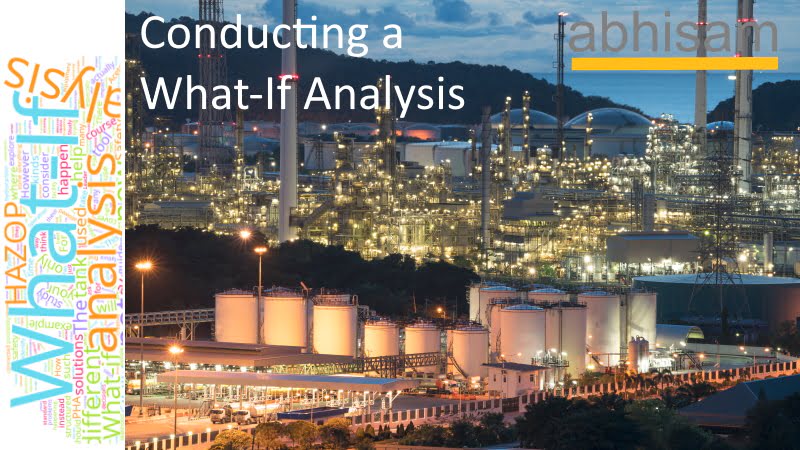In this short guide we will take a look at What-If Analysis, for conducting a risk assessment of your plant or facility. This is a faster alternative to conducting a full HAZOP study.
What is What-If Analysis?
What-if analysis is not used just for safety studies or risk assessments. It is actually a general brainstorming technique that can help you generate new ideas, think outside the box, and come up with creative solutions to problems.
It’s a simple idea: you take a problem or situation and ask, “What if…? ” Then, you come up with as many possible answers to that question as you can. The key to conducting a successful what-if analysis, is to not limit yourself to realistic solutions; instead, think of anything and everything that could happen, no matter how far-fetched it may seem.
What-if analysis is a tool that can be used to generate new ideas by considering different potential outcomes. This type of analysis can be used to conduct thought experiments on new ideas, or to evaluate the potential impact of different decisions.
What-if analysis can be a helpful tool for generating completely new ideas, or evaluating the potential impact of older ones or the consequences of different decisions. If you are stuck on a problem, or if you need to make a decision, consider conducting a what-if analysis to help you generate new ideas or to better understand the potential consequences of your decision.
What are the Different Types of What-If Analysis?
There are a few different types of what-if analysis, including:
“What if we change X?”
“What if we do Y instead of X?”
“What if we add Z to our plan?”
Asking these types of questions can help you to get new ideas and come up with creative solutions to problems.
Business applications use What If analysis tools in Excel, to programmatically change different values to see what happens, such as how changing energy prices will impact manufacturing costs, or how employee staffing cost increases can impact profits.
What-if analysis is a valuable tool that can be used in many different situations. Whether you’re trying to come up with a new product idea or you’re trying to find a way to improve your current business model, what-if analysis can help you to explore all of the possibilities and make the best decision for your situation.
However in this guide, we will only be covering it’s use as a technique for Process Hazard Analysis or PHA for short.
How to conduct a What-If Analysis?
What-if analysis can be conducted in a number of different ways. One common method is to consider different scenarios and then brainstorm possible solutions for each one. For example, you might consider what would happen if a storage tank got overfilled, or if a pump tripped suddenly in the middle of a hydrocarbon transferring operation.
Types of What If Analysis for Safety Studies
There are two kinds of What-If Analysis. The first one is the traditional “open” What-If Analysis, where all kinds of questions are allowed. This is a pure brainstorming technique where all types of (even those that sound outlandish) can be asked, to generate new ideas and thoughts.
But this is not what is useful in a Safety Study, or a PHA where time and money are both limited. Hence for such situations, we use something known as SWIFT-Structured What-If Analysis.
The Abhisam What-If Analysis training course uses SWIFT concepts. This means only certain sets of questions are allowed, those that are potentially easily probable to happen in practice.
Note: The Abhisam What-If Analysis course is the fastest and easiest way to learn as well as get certified in this technique. Click the image below to know more.
For example, consider a Road Tanker (Tank Truck) that is full of a volatile and flammable hydrocarbon (lets say Acetone) that needs to be unloaded into an underground tank in the tank farm of a facility.
To carry out a quick Hazard and Risk Assessment, we can use the What-If analysis technique to do this, instead of the traditionally popular (but more time consuming), HAZOP (Hazop is short for Hazard and Operability Study. We cover this in detail in the HAZOP training course as well as in the HAZOP Leader course).
We ask what-if analysis questions such as:
- What if the Acetone tanker is connected for unloading to the wrong tank?
- What if the hose pipe connected to the tank leaks?
- What happens if the underground tank overfills?’
and so on. (There are many more questions, the above are just to give you an idea of the method).
Every question then leads to an answer that may have bad consequences, or may have benign consequences. The likelihood of occurrence of the possibility of this happening and the consequences are tabulated.
The ones with the bad consequences and high likelihood of occurrence are studied in more detail and protection mechanisms can be devised to prevent these situations from actually occurring.
What-If Questions are structured around Process Deviations, human errors (and even sabotage) and equipment failure. Thus they can also be used to estimate consequences of a cyber attack.
You can know everything about What-If questions in the Abhisam What-If Analysis course, with examples and case studies of actual operations situations.
Does OSHA approve of What-If Analysis?
Yes, in fact OSHA (US Occupational Safety and Health Administration) has listed What-If Analysis as one of the techniques for conducting PHA, as part of the PSM (Process Safety Management Standard- OSHA 1910.119). See Clause 1910.119(e)(2)(i) for a reference to What-If analysis.
Comparing What-If Analysis and HAZOP
There are some people who are confused between the two techniques and often state that they are the same technique. However, they are not the same and have several differences. For example
- HAZOP requires a multidisciplinary team with a HAZOP Leader who directs the study.
- HAZOP is highly structured with guide words decided at the beginning of the study.
- What-If is in comparison less structured although SWIFT is more structured than open What-If.
- What-If can be done by smaller teams of people.
- What-If aims to generate possibilities faster and requires less time.
- What-If uses standard checklists and questions.
What are the Advantages of Using What-If Analysis?
- What-if analysis is a powerful tool that can help you generate new ideas, explore different possibilities, and find the best solution to a problem.
- What-if analysis can help you identify potential risks and plan for them.
- What-If Analysis is approved by OSHA as one of the methods to conduct a PHA for facilities covered under the PSM standard.
- SWIFT (Structured What-If analysis) is a faster alternative to conducting a HAZOP.
- The traditional What-If analysis technique can lead to uncovering more possibilities, than a HAZOP, especially when enough information about the process is not available.
How do you Develop “What If” Questions?
What-if questions are a great way to generate new ideas and to think creatively. To develop what-if questions, you need to first identify a problem or challenge that you are facing. Once you have identified the problem, you can start to brainstorm possible solutions.
However in the context of a safety risk assessment the questions should only cover certain scenarios that can happen (and are likely) due to reasons such as equipment failure and human errors.
It should not be a “free for all” session where any and all kinds of questions can be asked, even those with a remote possibility of happening. Thus, the SWIFT method is the preferred one for conducting a PHA.
What are some Examples of What-If Analysis?
What if analysis can be used for evaluating the safety of any unit operation, such as unloading of the Acetone tank truck in the example shown.
When you take the Abhisam What-If analysis you will see sample What-If questions for many unit operations and worksheets.
What are the Disadvantages of What-If Analysis?
- What-If is not as rigorous as HAZOP and may not cover all the possibilities, especially if using the SWIFT version.
- What-If analysis should be done only by trained personnel, however this applies to any technique and not just What-If.
- The right questions need to be asked to generate possibilities that can actually happen. It will not work if the right questions are not asked in the study sessions.


